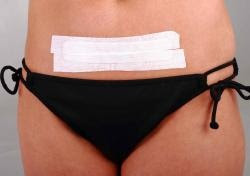Anal bleaching isn’t just something porn stars and Bridesmaids characters do. More and more women are whitening back there...
from Cosmopolitan magazine
 |
| Wadley |
One of the most genius moments in Bridesmaids was when Kristin Wiig’s character very creatively disses fellow bridesmaid, uptight Helen, by accusing her of getting anal bleaching, insinuating that paying for a perfectly white bunghole was a sign of being prissy and just plain ridiculous. Then Maya Rudolph’s character Lillian turns that diss back around and said that yep, Helen had bleached her bum and she knew that because they’d gone together and they love their new, spotless anuses.
Well, it turns out Helen and Lillian aren’t alone in their decision to lighten up their rears; it’s a growing trend. But MDs say it’s not as simple and risk-free as spas make it sound. Read on to find out the deal with painting your backdoor white.
What Is Anal Bleaching Anyway?
It’s exactly what it sounds like and what is sounds like is frankly some sort of torture technique. An acid is applied to your freshly waxed anus and rubbed in, according to the spas we contacted that provide the service. Most places offer the initial application at the spa for about $100-150, then sell you a set of the bleaching lotion or gel to use at home. The whole in-spa process takes about 20 minutes, one Sacramento technician told us. Depending on how dark your skin is, you may need to reapply a number of times to see results. One Los Angeles spa even said that for some people they recommend applying it twice a week for up to eight weeks. And almost all of the spas we called were quick to let us know that customers could also opt for a package that includes both anal bleaching and vulva lightening, in which the bleach is applied to the opening of the vagina.
A Trend, Inspired by Stars
Porn stars, that is. There’s a widely believed rumor that a very famous former adult film star turned TV actress, who shall remain unnamed, got a full front-to-back wax one day and, upon seeing her totally bare nethers, asked the waxer if there was anything she could do to get rid of her anus’s dark hue. And so, anal bleaching was invented—though it was really only done by porn stars at first.
As Brazilians grew in popularity, more and more women began noticing that their anuses were darker than the rest of their skin. (This is totally common and normal, by the way, explains women’s health expert, Jennifer Wider, MD.) An employee at one Colorado spa said, “[Our technicians] do a lot of Brazilian waxes and sometimes the clients are surprised to see dark skin underneath. They are more self-conscious about the skin discoloration, so they want [it] lightened.”
In addition, porn became more ubiquitous, meaning more men and women were, well, exposed to bleached rear entrances, giving some of them a new idea of what a beautiful bum should look like. Add that to the fact that, according to information from the Center for Disease Control, anal sex is on the rise among women, and it’s no surprise that females were suddenly concerned with what they looked like from behind. Now, spas offering the bleaching say the product sells so quickly, they can hardly keep it on shelves. And many of the technicians affirmed they’ve noticed a definite spike in appointments booked in the past few years.
read the whole article here:
http://www.cosmopolitan.com/advice/health/anal-bleaching-trend
 What factors would contribute to higher satisfaction in the bedroom?
What factors would contribute to higher satisfaction in the bedroom?








